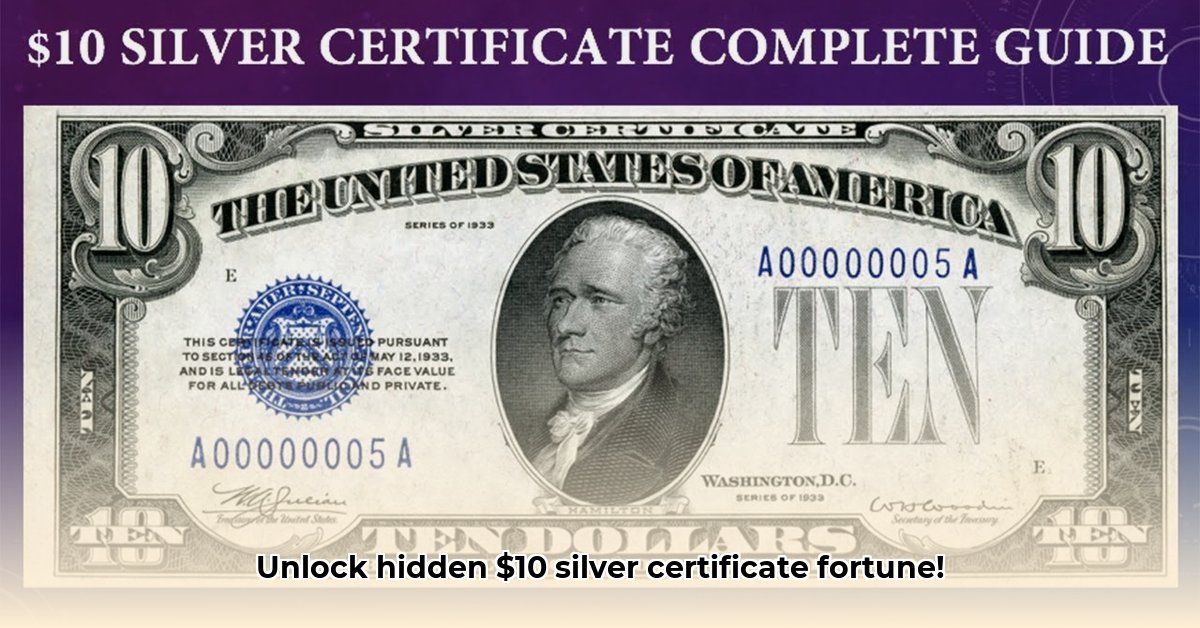
Investing in $10 Silver Certificates offers a unique blend of historical significance and potential financial return. This guide provides a comprehensive approach to evaluating and strategically acquiring these collectible banknotes, covering everything from identifying key features to building a diversified portfolio. Whether you're a seasoned numismatist or a curious beginner, this instructional guide will equip you with the knowledge and strategies to navigate the world of $10 Silver Certificates. For more on specific bill values, see this helpful resource: 1969 $5 bill value.
Understanding $10 Silver Certificates: A Piece of American History
Issued between 1878 and 1963, $10 Silver Certificates represent a tangible piece of American financial history. Their value hinges on a combination of factors, including their design, rarity, and condition. Two main types exist: large-size notes (printed before 1928) and small-size notes (printed from 1928 onwards). Large-size notes are generally rarer and more valuable due to their limited print runs. Specific series and designs, such as the 1891 "Tombstone" series featuring its distinctive imagery, command higher premiums among collectors. The historical context surrounding these certificates further enhances their appeal and value. Isn't it fascinating to own a piece of history?
Key Factors Affecting Value: Condition, Rarity, and More
Several critical factors influence the value of a $10 Silver Certificate:
Condition: The Sheldon Scale and its Significance
The Sheldon grading scale, ranging from 1 (Poor) to 70 (Gem Uncirculated), is the industry standard for assessing a note's condition. A certificate in pristine condition (closer to 70) will command a significantly higher price than a heavily circulated note (closer to 1). Even minor imperfections, such as small tears or stains, can drastically reduce a note's grade and value. Think of it like this: Would you pay the same price for a new car as for a used car with significant damage?
Rarity: The Power of Limited Prints
Specific years and series of $10 Silver Certificates are far rarer than others, directly impacting their value. For instance, notes from the early years of issuance (late 1800s) often hold greater value due to their limited print runs. Certain design variations, like the 1891 "Tombstone" series, are also considered more desirable. The concept is similar to limited-edition collectibles; rarity inflates demand and prices.
Serial Numbers: The Unexpected Value of Numbers
Interestingly, a note's serial number can significantly impact its value. Collectors seek out "fancy" serial numbers, such as low numbers, repeating digits, or numbers forming patterns. These unique serial numbers enhance a certificate's desirability and value within the collector's market. This is a subtle detail that often surprises new collectors. Did you know that specific serial number patterns can impact value by a significant margin?
Professional grading is crucial for accurate valuation. Discrepancies across different sources emphasize the importance of professional assessment.
Identifying Rare and Valuable Notes: A Collector's Checklist
To identify a valuable $10 Silver Certificate, follow these steps:
Date and Series Identification: Determine the note's year and series. Research online resources to learn about the rarity of that particular issue and the corresponding market values.
Condition Assessment: Carefully examine the note for any damage, including tears, creases, stains, or discoloration. If possible, compare your note to images of various graded notes online. This helps you understand the appropriate grade you can expect.
Serial Number Analysis: Look for unique serial number patterns or low numbers, repeating digits, or any other distinguishing characteristics. These "fancy" features often elevate a note's value.
Authenticity Verification: This step is critical. Counterfeit notes exist. Use reputable online resources, consult experienced collectors, or utilize professional authentication services to confirm your note's authenticity, particularly for high-value certificates.
Where to Buy and Sell: Finding Safe Havens for Your Investment
Several reputable avenues exist for buying, selling, and trading $10 Silver Certificates:
Online Marketplaces: Use established platforms like eBay, but proceed with caution, verifying seller reputations and ensuring the note's authenticity before purchasing.
Auction Houses: Reputable auction houses, such as Heritage Auctions, offer a degree of trust and authenticity verification, especially for valuable notes.
Coin Dealers: Local coin shops and certified coin dealers can provide valuable expertise, guidance, and potentially access to lesser-known notes.
Professional authentication adds value and is essential for high-value notes.
Building a Collection: A Strategic Approach to Collecting
Building a successful collection is a long-term strategy that requires patience and careful planning.
Diversification: Spread your investment across various years, series, and conditions to mitigate risk. Don't concentrate on one specific area, to avoid concentrating risk in a single area.
Gradual Acquisition: Avoid impulse purchases. Build your collection gradually, focusing on informed acquisitions rather than quick wins.
Professional Grading: Consider having high-value notes professionally graded to ensure accuracy and enhance their market value.
Continuous Learning: Stay updated on market trends, rarity changes, and grading standards. The collector's market is alive and constantly shifting.
Conclusion: Due Diligence is Key
Investing in $10 Silver Certificates can be a rewarding experience, combining financial opportunity with historical appreciation. However, success hinges on thorough research, diligent verification, and a strategic approach to collection building. By following the guidelines outlined in this guide, you'll equip yourself to navigate the exciting world of $10 Silver Certificates with confidence and increase your chances of achieving valuable returns on your investment. Remember, professional authentication and expert advice are invaluable tools to navigate this intriguing market effectively.